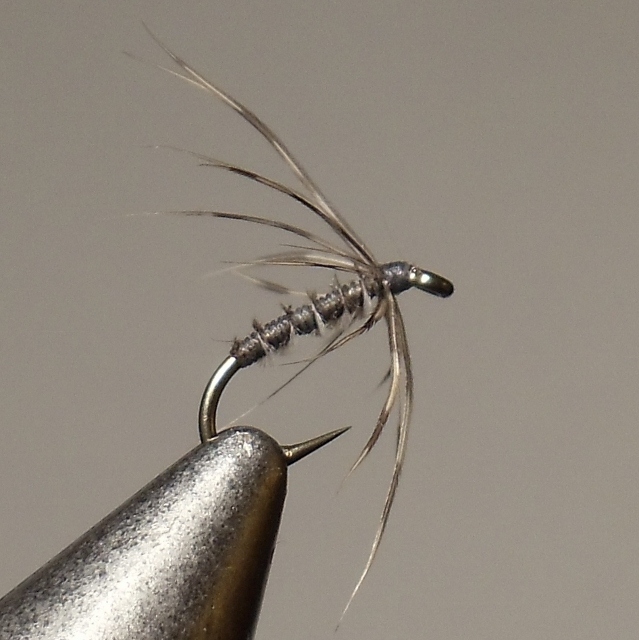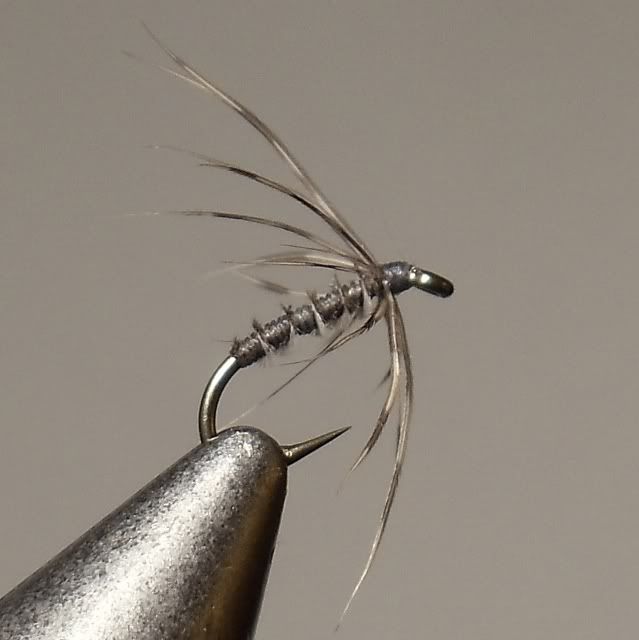Page 1 of 1
Old Master
Posted: Wed Jul 27, 2011 12:35 pm
by tie2fish
I'm embarking on an attempt to tie all of what Roger Fogg refers to as "North-Country Flies or 'Spiders' " in his 2009 work entitled
Wet-Fly Tying and Fishing. Some of these patterns, such as the Old Master, are not illustrated, so my reditions will be based on a combination of the recipes given plus any comments made by the author. According to Fogg, Pritt attributed the Old Master pattern to a Mr Bradley from Otley, and regarded it to be a "capital killer" throughout the season.
Hook: Daiichi 1530, #16
Thread: Petitjohn grey (lacking Persall's #10 ash)
Hackle: Woodcock underwing covert
Body: Thread in touching turns, wrapped over with open turns of undyed heron

Re: Old Master
Posted: Wed Jul 27, 2011 1:07 pm
by hankaye
tie2fish, Howdy;
Beautiful fly, and outstanding photo of it.
Looking forword to the rest.
hank
Re: Old Master
Posted: Wed Jul 27, 2011 2:20 pm
by narcodog
tie2fish wrote:I'm embarking on an attempt to tie all of what Roger Fogg refers to as "North-Country Flies or 'Spiders' " in his 2009 work entitled
Wet-Fly Tying and Fishing. Some of these patterns, such as the Old Master, are not illustrated, so my reditions will be based on a combination of the recipes given plus any comments made by the author. According to Fogg, Pritt attributed the Old Master pattern to a Mr Bradley from Otley, and regarded it to be a "capital killer" throughout the season.
Hook: Daiichi 1530, #16
Thread: Petitjohn grey (lacking Persall's #10 ash)
Hackle: Woodcock underwing covert
Body: Thread in touching turns, wrapped over with open turns of undyed heron

T2F; Just to let you know Ash no. 10 is not gray it is more light tan..
Re: Old Master
Posted: Wed Jul 27, 2011 2:47 pm
by tie2fish
Thanks, Bob. In his recipe, Fogg calls for " ... ash colored or pale grey tying silk (Pearsall's shades 10 or 9a)"; having neither, I went with the Petitjean grey.
Re: Old Master
Posted: Wed Jul 27, 2011 6:11 pm
by willowhead
Sweet...........

Re: Old Master
Posted: Fri Jul 29, 2011 9:09 am
by North Country Angler
The Old Master is a great pattern in these parts when the small midges are eating you alive. The history of the pattern is somewhat clouded in mystery as Magee in his book states it was invented by Robert Bradley of Otley in 1870, but in previous pages he states is is in the Pilling manuscript of 1794 so there is a bit of confusion in regards to the originator and the date. However Pritt quotes Bradley as saying " The Greenwells Glory was the old master and the fly he always turned to" So in all probability Bradley didn't invent the Old Master it was just a coincidence that there was already a fly of that name. Pritt was not a fly-tier and in reality got all his dressing and information for his book 3rd hand. The section of Pritt's book about worm fishing was in all probability written by someone else, certainly the drawings were produced and given to him by someone else in the Kilnsey Club. When Pritt died and and a subscription was formed to pay for the publishing of a posthumous book, interestingly his best friend didn't take a subscription. Is it because he didn't get the credit for the worming section of the book ? We will never know.
Re: Old Master
Posted: Fri Jul 29, 2011 2:18 pm
by William Anderson
Bill, one of the things that I like best about this pattern is the subtle blending of color and contrast in the materials. This is a nice tie. Let me know how it works on the GP. No doubt an effective pattern as an olive dun around here.
When I posted an Old Master from the list Bradley recorded, I mentioned that I didn't know what imitation was intended. Ruard and Donald both came up with comments regarding Greenwell's Glory.
"This is a capital killer from April to the end of August on warm days or in the evenings. It was originally dressed by Bradley, of Otley....It bears resemblance to "Greenwell's Glory"
The Greenwell is according to Courtney Williams an imitation of an Olive dun or a dark Olive Dun.
NCA, for every writer/publisher who made a list, weren't there hundreds of tiers/fishermen who also invented spiders to imitate Olives? If you take all the manuscripts available with North Country Fly lists included, it seems you get a glimps of reality, but nothing to hang you hat on. They all are similar, all varied, derived from un-named tiers and more interesting in their comparisons than in themselves. I'm very interested in your knowledge of these flies as I hold a nagging curiuosity about them and a pocket full of references, some contradictory, which adds to their appeal for me. I like the questions as much as the answers.
w
Re: Old Master
Posted: Fri Jul 29, 2011 3:39 pm
by North Country Angler
William,
I totally agree with you, the more you dig the deeper you get! Every time I think I have got it sussed someone gives me more reference material and unknown manuscripts and then I have got to go back and rewrite my history chapter. In regards to Bradley he dressed his Greenwell with a Woodcock wing which was quite common in Yorkshire at the time. Fly lists and manuscripts were not as common as people think in relation to the North Country Flies it was just that these few lists were copied by others. There is one definitive list that pre-dates and links all the North Country patterns that follow. And it is locked in my tying desk

All will be revealed in the fullness of time



